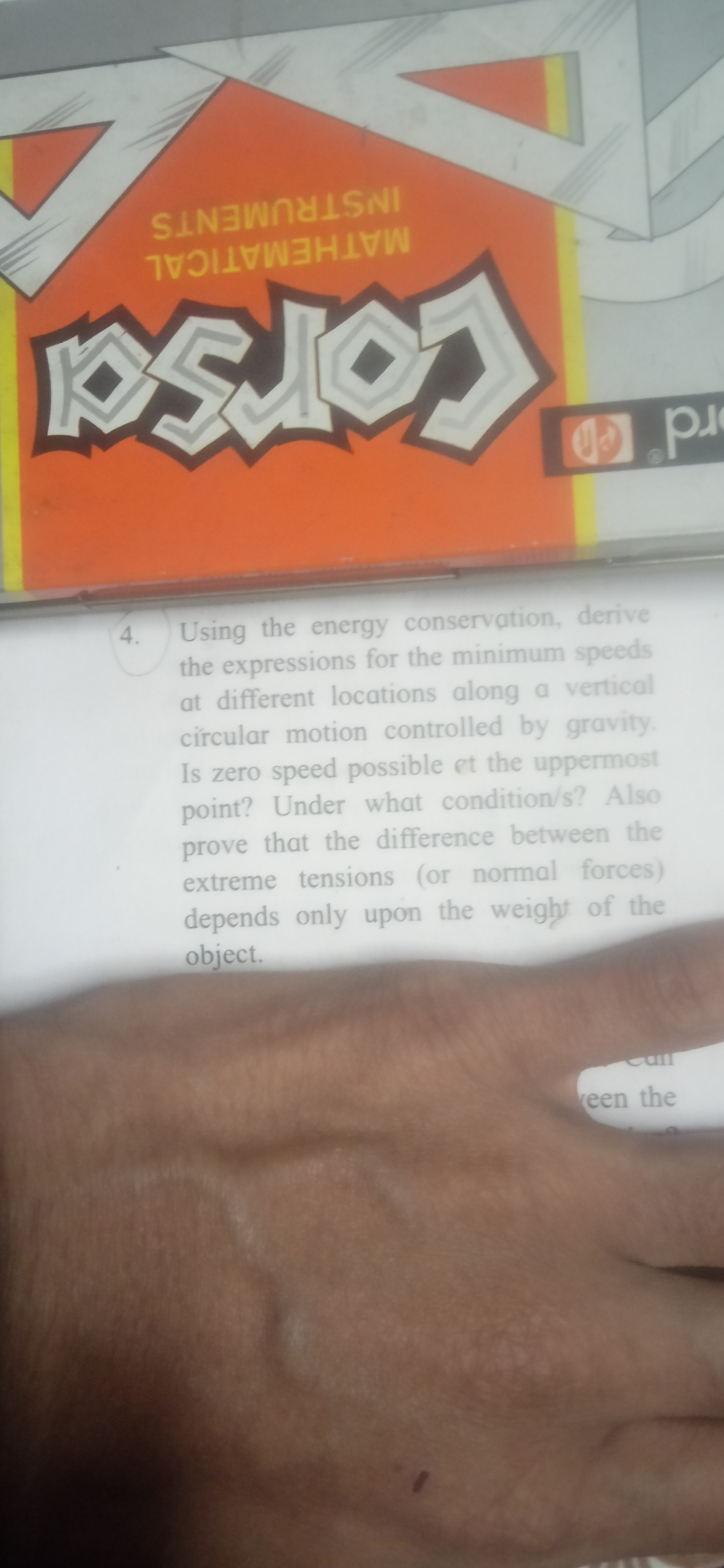Using the energy conservation, derive the expressions for the minimum speeds at different locations along a vertical circular motion controlled by gravity. Is zero speed possible a... Using the energy conservation, derive the expressions for the minimum speeds at different locations along a vertical circular motion controlled by gravity. Is zero speed possible at the uppermost point? Under what condition/s? Also prove that the difference between the extreme tensions (or normal forces) depends only upon the weight of the object.

Understand the Problem
The question is asking to derive expressions related to minimum speeds for vertical circular motion and to explore conditions regarding zero speed at the uppermost point, as well as proving the dependency of tension on the weight of the object.
Answer
The minimum speed at the top is \( v_t = \sqrt{gr} \) and at the bottom is \( v_b = \sqrt{5gr} \); zero speed is possible at the top under specific conditions.
Answer for screen readers
The minimum speed at the top of the circle is given by ( v_t = \sqrt{gr} ), and at the bottom by ( v_b = \sqrt{5gr} ). Zero speed is possible at the top if the energy balance allows for no kinetic energy.
Steps to Solve
-
Understanding Energy Conservation
The principle of conservation of energy states that the total mechanical energy (kinetic + potential) in a system remains constant if only conservative forces (like gravity) act on it. -
Kinetic and Potential Energy at Different Points
At any point in the vertical circle of radius ( r ):
- Kinetic Energy (KE) is given by ( KE = \frac{1}{2}mv^2 )
- Potential Energy (PE) at height ( h ) is given by ( PE = mgh )
-
At the Top of the Circle
At the top of the circle, the height is ( 2r ). Setting up the energy equation:
$$ KE_{top} + PE_{top} = KE_{bottom} + PE_{bottom} $$
Substituting gives:
$$ \frac{1}{2}mv_t^2 + mg(2r) = \frac{1}{2}mv_b^2 + mg(0) $$ -
Minimum Speed at the Top
For minimum speed (( v_t )) at the top to maintain circular motion, the centripetal force must be provided by the gravitational force:
$$ \frac{mv_t^2}{r} = mg \implies v_t^2 = gr
$$
Thus,
$$ v_t = \sqrt{gr} $$ -
At the Bottom of the Circle
At the bottom of the circle (height = 0):
Using the energy conservation principle:
$$ \frac{1}{2}mv_b^2 + mg(0) = \frac{1}{2}mv_t^2 + mg(2r) $$
Simplifying gives: $$ \frac{1}{2}mv_b^2 = \frac{1}{2}m(gr) + mg(2r) $$
Thus,
$$ v_b^2 = gr + 4gr = 5gr \implies v_b = \sqrt{5gr} $$ -
Comparing Tensions at Different Points
At the top of the circle: $$ T_{top} + mg = \frac{mv_t^2}{r} \implies T_{top} = \frac{mv_t^2}{r} - mg $$
At the bottom of the circle: $$ T_{bottom} - mg = \frac{mv_b^2}{r} \implies T_{bottom} = \frac{mv_b^2}{r} + mg $$ -
Condition for Zero Speed at the Top
Zero speed (( v_t = 0 )) at the top can occur if the height is such that potential energy equals total energy, which means vertical motion must stop at the top: $$ mg(2r) = \frac{1}{2}mv_t^2 = 0 $$ This occurs at the critical point of the highest height feasible without motion.
The minimum speed at the top of the circle is given by ( v_t = \sqrt{gr} ), and at the bottom by ( v_b = \sqrt{5gr} ). Zero speed is possible at the top if the energy balance allows for no kinetic energy.
More Information
The analysis of vertical circular motion is crucial in understanding concepts related to forces, energy conservation, and motion dynamics. The minimum speed helps in determining the stability of circular motion under gravitational force.
Tips
- Confusing gravitational potential energy with kinetic energy when calculating speeds.
- Not considering the centripetal force requirement at both the top and bottom points of the motion.
- Failing to maintain correct units during calculations.
AI-generated content may contain errors. Please verify critical information